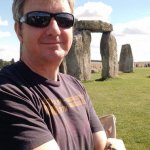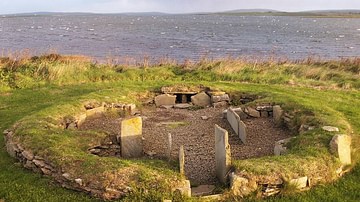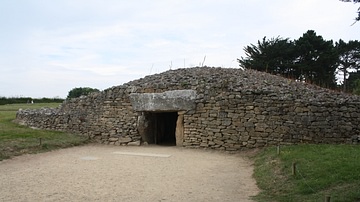The Rollright Stones is the collective name for a group of enigmatic prehistoric monuments located next to an ancient ridgeway known as the Jurassic Way, on the border between the English counties of Oxfordshire and Warwickshire. The name 'Rollright' derives from Hrolla-landriht, 'the land of Hrolla.' The complex of monuments at the site consists of three main elements, the 'King's Men' – a circle of about seventy stones, probably dating to around 2500 BCE, the 'King Stone' – a solitary weathered monolith dated to 1792 BCE, and the 'Whispering Knights' – the remains of the burial chamber of a Middle to Late Neolithic portal dolmen, estimated to date to between 3800 and 3000 BCE. There are also two further monuments, both almost completely destroyed, a round cairn (a roughly hemispherical burial mound constructed primarily of stones), and a ditched round barrow (a hemispherical burial mound).
In the neighbourhood of Oxford there are great stones, arranged as it were in some connection by the hand of man. But at what time; or by what people; or for what memorial or significance, is unknown. Though the place is called by the inhabitants Rollendrith. (De Mirabilibus Britanniae, 11th century)
Witchcraft
Though not as grand and well preserved as the Avebury or Stonehenge ritual landscapes, the Rollright monuments possess their own unique atmosphere, and have attracted a wealth of supernatural folklore over the centuries involving witches, fairies, invading 'Danes,' and the famous prophetess Mother Shipton. Indeed, the monuments in the area seem to have attracted more legends than almost any other prehistoric site in England.
The earliest known belief about the stones, that they were petrified men, is first mentioned in Camden's Britannia, written in Latin, in 1586 CE, which states that "the common people usually call them Rolle-rick stones, and dreameth that they were sometimes men by a wonderful Metamorphosis turned into hard stones."
Writing in the journal Folklore (September 1902) Percy Manning mentions perhaps the earliest appearance of a well-known rhyme about the Rollright Stones, added as manuscript notes to his copy of Dr. R. Plot's Natural History of Oxfordshire, (2nd edition. 1705):
Said the Danish General, / If Long Compton I cou'd see / Then King of England I shou'd be. / But reply'd the ["British" erased] Saxon General, Then rise up Hill & stand fast Stone- / For King of England thou'lt be none.
By the mid-19th century CE, the 'Saxon General' had been replaced by a witch. The witch confronts a conquering king at Rollright who is a few steps away from the crest of the ridge from where the village of Long Compton, lying in the valley below, is visible. According to the most complete version of the tale, collected by Arthur Evans from local people and published in Folklore in 1895 CE, the witch stopped the King in his tracks by saying: 'Seven long strides shalt thou take, and if Long Compton thou canst see, King of England thou shalt be.' Realizing that the village would certainly be visible from the edge of the hill the King strode forward shouting: 'Stick, stock, stone, As King of England I shall be known!' Taking seven strides forward the King was suddenly confronted by a long mound of earth rising up magically before him (the mound of earth which still stands next to the King Stone) and blocking his view of the valley below. The witch then said: 'As Long Compton thou canst not see / King of England thou shalt not be. / Rise up, stick, and stand still, stone, / For King of England thou shalt be none, / Thou and thy men hoar stones shall be / And I myself an eldern-tree.' And so the King and his army became the King Stone and King's Men stone circle and the witch became an elder tree. The Whispering Knights were said to be a group of soldiers huddled together plotting treachery against the King when they were also turned to stone by the witch. The witch in this tale was sometimes identified as the mythical prophetess Mother Shipton, probably for no other reason than the proximity to Rollright of a village called Shipton-under-Wychwood.
As this folktale shows the stones have a connection in the popular imagination with witchcraft, though how far back this connection goes is not clear. Writing in the magazine 3rd Stone (Winter 2000/2001) folklorist Jennifer Westwood has shown that both the witch and the related elder tree elements of Rollright folklore are of comparatively recent date, there being no evidence for either motif earlier than the mid-19th century in stories from the site. In fact, in versions of the petrification tale from earlier in the 19th century CE it is not a witch but a 'magician' who turns the King and his army to stone.

The witch element at Rollright seems to have become popular due to the fact that the village of Long Compton and the surrounding area had a reputation for witchcraft in the 19th century CE, though the region does not seem to have been noted for its witches during the witchcraft persecutions of the 16th and 17th centuries CE. In September 1875 CE, an old woman of Long Compton named Anne Turner was stabbed to death with a pitchfork by a feebleminded agricultural laborer called James Haywood, who believed her to be the head of a local witch coven who had cursed him. The local belief in witches was still strong in 1945 CE, when another murder occurred, this time on Meon Hill, near Lower Quinton, a few miles to the north-west of Rollright. On Valentines Day, a hedger named Charles Walton was found pinned to the ground with a hayfork, with a cross carved into his chest and neck. The murder was never solved, although some suspected a ritual or 'witchcraft' related killing, though no evidence was ever produced for this. Over the last few decades the Rollright Stones have attracted followers of modern witchcraft, or 'Wiccans', as well as other pagan and ritual magic groups who still hold ceremonies within the stone circle today.
Fairies
Fairies are often connected in folklore with prehistoric monuments and the Rollrights are no exception. In the late 19th century Arthur Evans was told that a man named Will Hughes from the village of Long Compton, had once seen fairies dancing around the King Stone and described them as 'little folk like girls to look at.' Will Hughes' widow, Betsey (whose mother had apparently been 'murdered as a witch'), a woman between 70 and 80 years of age when interviewed by Evans, told him that when she was a little girl working in the hedgerows there was a gap in the bank close to the King Stone, from where fairies emerged to dance at night. Betsey and her friends had often placed a flat stone over the hole in the evening to keep the fairies in, only to find it turned over the next morning.
Megalithic folklore
The folklore of the Rollright Stones contains three of the standard motifs connected with megalithic monuments. The first is that whoever removes a stone from the site will suffer the consequences, well illustrated by the tale of the farmer who took away the capstone of the Whispering Knights to act as a bridge across the brook at Little Rollright. After an exhausting ordeal using 'a score of horses' to drag the stone down to the brook, the farmer and his helpers laid it across to form the bridge. But every morning the stone was found lying in the grass having somehow turned over in the night. Deciding that the stone was more trouble than it was worth the farmer managed to return it using only a single horse to pull it up the hill.
Another common element in megalithic folklore is the idea that it is impossible to accurately count the number of stones at a site. There is a story from Rollright about a baker who placed a loaf of bread on every stone in order to count them correctly, but no matter how he laid them out, he always found one stone without a loaf in the end.
The third motif connected with megaliths is that of 'drinking stones'. It is said that the King Stone and the Whispering Knights go down the hill at midnight to drink from a spring in Little Rollright Spinney. The Banbury Stone, Worcestershire, the Whetstone at Kington in Herefordshire, and the Hoarstone at Enstone in Oxfordshire are other examples of 'drinking stones'.

Unfortunately, the recent history of the Rollright Stones, now owned by the Rollright Trust, has been far from pleasant. Over the past few years, the stones have been repeatedly vandalized. In March 2004 CE many of the Kings Men were daubed in yellow paint, whilst on March 23, 2006 CE, the warden's hut at the site was broken into and burnt to the ground. The latest act of mindless vandalism occurred in September 2007 CE when the monument plaque at the King Stone was wrenched off the railings and broken, and the information board daubed in graffiti. More seriously, a tyre was forced over one of the stones in the King's Men circle, filled with wood and set alight, blackening a large part of the stone and causing cracks to appear around its circumference. What provokes such acts is unclear, but George Lambrick, chairman of the Rollright Trust charity, has said that they are now considering "installing some kind of CCTV system here to deter further attacks." Such action may indeed be necessary if we are to preserve what is left of the ancient ritual landscape at Rollright before it is too late.









